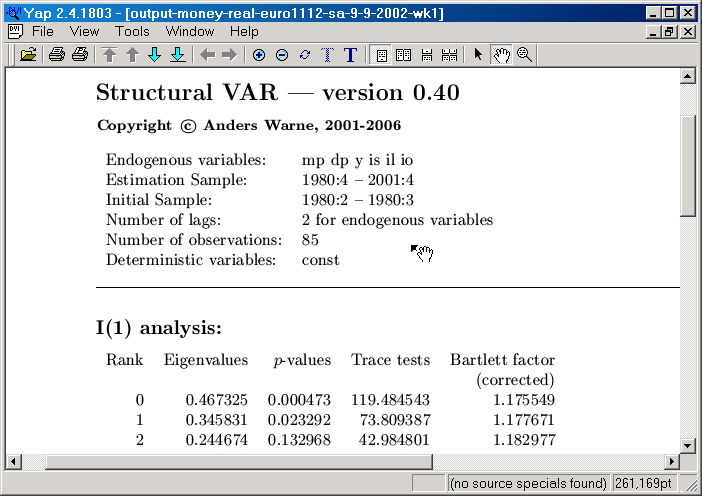| • | Don't write to output file. |
Disables writing to an output file. While generally not recommended, this option speeds up the running of the program and may be useful when checking certain results from the analysis.
| • | Open output file after estimation. |
When this option has been checked the newly created or appended output file will be opened by SVAR after the estimation function has completed its mission.
| • | Append new results to existing output file. |
By default SVAR overwrites an existing output file. By selecting this option, the software will instead append the new results to an existing output file.
| • | Write short-run dynamics and the C-matrix to output file. |
Writes the estimated short-run parameters and the covariances with standard errors to output.
| • | Write Granger causality tests to output file. |
Computes Granger causality tests for the levels, taking unit roots and the selected cointegration relations into account. The Granger causality procedure assumes that all non-zero values in β are non-zero, such that the Wald test has an asymptotic chi-2 distribution. If the option is selected and the model has at least 3 endogenous variables, then multi-step Granger causality tests will also be calculated and written to the output file; see Lütkepohl and Burda (1997) for details.
| • | Write exclusion tests to output file. |
The equation based exclusion tests for lagged first differences of endogenous variables, current and lagged first differences of exogenous I(1) variables, and current and lagged levels of exogenous I(0) variables are calculated and written to the output file if this option is check marked. The tests are all of the Wald type.
| • | Write LSTR1 parameter constancy tests to output file. |
The LSTR1 (see Teräsvirta (1998)) statistics test the null of parameter constancy for a set of parameters against a logistic STR model of order one for the same set of parameters, where the transition variable is a linear trend. Both a first and a third order Taylor expansion is used in the computation of the LM and the F-test. Four sets of parameters are considered: deterministic variables, lagged endogenous variables, exogenous variables, and cointegration relations. For this option to be effective, you must have checked the "Parameter Constancy Tests" box in the main program window.
| • | Write Chow tests to output file. |
By default SVAR doesn't write any Chow tests to output. When this option is checked, the program will do just that.
| • | Write results to output with x decimals. |
By default SVAR uses 4 decimals for both file and screen output. This option lets you select the number of decimals for such operations within the range of 2 to 8 decimals
| • | Export data to text file with x decimals. |
The default value for x is 8, but any integer between 4 and 12 can be selected. The selected value affects exports of data from axes objects and saving residuals, transitory and permanent components, as well as cointegration relations.
| • | PDF version for Ghostscript. |
Whenever you want to create PDF files from graphics figures or for viewing the output file as PDF and the creator of the PDF is Ghostscript, you can change the PDF version that the file should adhere to through this popup control. By default it's set at version 1.2. But you may change it to later PDF version, namely 1.3 and 1.4.
| • | Output format. |
You can choose between plain text format and LaTeX format. The default is plain text.
|
Figure: The DVI-viewer YAP from MiKTeX displaying an output file. |



